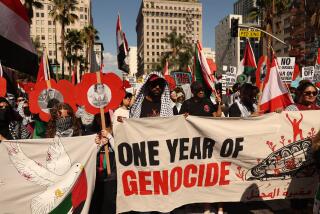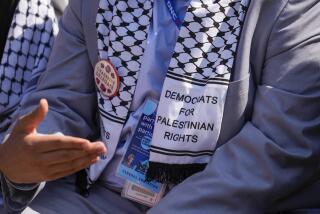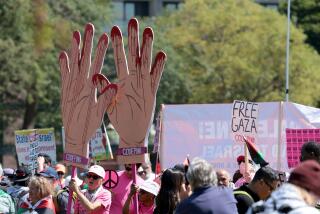Anti-War Movement Is a Kaleidoscope of Many, Varied Views : Peace groups: It represents a broad coalition of people disenchanted with government policies. But they must work to blend differing causes.
WASHINGTON — Leaders of the burgeoning anti-war movement suggest that President Bush’s decision to attack Iraq could galvanize a broad coalition of people long disenchanted with government policies regarding civil rights, education, health care and other social issues.
But first, say observers of the anti-war movement, the activists must work among themselves to bridge a wide range of political views and causes represented by the emerging coalitions against the Persian Gulf War.
Today is considered a key test of the movement’s strength. While opinion polls show that a strong majority of Americans now favor the U.S.-led military strike, thousands of anti-war protesters are expected to march on the White House while synchronized demonstrations are held in other major cities. In Los Angeles, thousands are expected to parade through Westwood, symbolically ending their demonstration at the Veteran’s Cemetery.
Their common purpose is to vent anger at the more than $1 billion the government expects to spend daily on the war--a sum many protesters say could be better used to fight domestic woes.
The many protesters come at the issue from different angles. They include African-American and Latino activists protesting the disproportionate numbers in the military from within their communities; homeless advocates pressing for increased funds for affordable housing and environmentalists calling for energy policies to guard against foreign-oil dependency.
There also will be gay activists seeking more support for AIDS research; pacifists and religious groups praying over the immorality of war; student groups protesting the retrenchment of federally supported scholarships and grants, and military families who contend that their sons and daughters should not be asked to risk their lives in a war over oil.
“Nothing is more urgent than stopping the Bush Administration’s march toward war,” declared a handbill released by the coalition promoting today’s Washington march. “Our fight is here at home to create peace, end U.S. military expenditures, stop racism, and for jobs, education, health care, housing and to end AIDS.”
The issues are being raised not only by protest organizers, but by such mainstream figures as Jackie Goldberg, president of the Los Angeles Unified School District, who sought to link the district’s $88 million in budget cuts with defense spending.
She was joined by ministers, environmentalists and gay activists at a press conference Friday on City Hall steps sponsored by 20/20 Vision, a national network that seeks to de-emphasize defense spending in favor of environmental and social concerns.
They cited a study by the National Priorities Project, a program at the University of Massachusetts showing that out of $117 billion paid in federal taxes by California residents, half went to military-related spending. By contrast, health care received 8.9%, education got 2.8%, the “war on drugs” 1%, and environmental protection still less.
The crisis in education, Goldberg said, “in part is a consequence of policies that destabilize the economy by transferring so many dollars to things that go up in smoke.”
Many activists are careful to say they support U.S. troops but not the policies that placed them overseas. Some say the United States was not necessarily wrong to go to war--but too hasty.
Critics of military spending say that U.S. foreign policy and its defense industries helped create Saddam Hussein in the first place. After destroying Hussein’s military machine, they ask, do we just keep spending more on ours?
The anti-war movement’s agenda, however, could be jeopardized by the course of the war and friction within. Their success in forming a cohesive anti-war movement will depend partly on the duration and severity of the battle and partly on their ability to link their individual causes to the cost of waging a protracted war in the gulf.
Evidence of friction among the groups already has cracked the surface solidarity of their struggle. Representatives of two of the nation’s leading anti-war coalitions--the Campaign for Peace in the Middle East and the National Coalition to Stop U.S. Intervention in the Middle East--will join ranks for today’s march in Washington. But the leadership of the coalitions--organized shortly after President Bush’s decision to send troops to Saudi Arabia--openly acknowledge they have divergent ideologies and espouse radically different approaches to ending the war.
“There is tremendous tactical divergence. . . . Some of the groups want to petition versus other groups that want to block freeways,” said Todd Gitlin, sociologist at UC Berkeley who has written extensively of the protest movements of the 1960s. While organizers may differ on agendas and tactics, “it’s not true of the rank and file,” he said. They “have one preoccupation front and center--ending the war.”
Of the two leading national anti-war networks, the Coalition to Stop U.S. Intervention is the more radical, drawing its membership from unions, grass-roots activists and minority-rights organizations. Its leaders, including former U.S. Atty. Gen. Ramsey Clark, have refused to condemn the Iraqi invasion of Kuwait. They are calling for massive acts of civil disobedience opposing U.S. involvement in the gulf.
Employing “people’s power” rhetoric of the ‘60s, Joyce Betries, a spokeswoman in the coalition’s New York headquarters, said the group pledges “to make this country ungovernable” until the war ends.
But some activists worry that the more radical among them may alienate people with flag-burnings and rhetoric that paints Bush as the moral equivalent of Hussein, if not worse.
The other national anti-war group, the Campaign for Peace, has a less-disruptive and more organizational approach. It has opposed the Iraqi invasion and plans to present the White House today with a million signatures of Americans opposed to the war. Among the 160 groups in the campaign are civil rights activists, religious leaders and veterans groups.
Some protest leaders, such as Jeremy Rifkin, a veteran of many ‘60s-era protests, hold out hope that a shared goal will enable the individual causes to rally as a single unit. In particular, he said today’s movement has an opportunity to redefine the issue of war as money wasted abroad as mounting domestic problems go ignored.
“President Bush’s war-mongering is keeping us from a whole new agenda for America in 1990,” Rifkin said.
Protest organizers have been heartened by the spontaneous and uncoordinated demonstrations and sit-ins at federal buildings in Los Angeles, San Franciso, Chicago, New York and other cities, as well as a seeming rebirth of activism on college campuses.
Arrests of protesters, mounting all week, continued Friday. At UCLA, 113 were cited for blocking access to the university’s administration building.
But David Little, senior scholar at the U.S. Institute of Peace in Washington, said the earliest demonstrations against U.S involvement in the Persian Gulf have been largely an emotional release by Americans who had been buoyed by developments in Europe and the apparent end to the Cold War.
A far more optimistic and aggressive view has prevailed among demonstrators in Los Angeles. Protest leaders such as disabled Vietnam veteran Ron Kovic, whose life story inspired the popular film “Born On the Fourth of July,” seems undeterred by polls showing that less than a third of Americans opposed the war.
Kovic tells crowds that they are witnessing the beginning of an American version of the sort of popular rebellions that have succeeded in Czechoslovakia and the Philippines, and have failed--so far--in China and Lithuania.
“I can feel an explosion about to happen,” Kovic said in an interview at the UCLA sit-in Thursday. “I think people are about to explode. It’s the recession, the homeless, the poverty, the unresolved agony of Vietnam.”
Times staff writer Shawn Hubler contributed to this story.
More to Read
Sign up for Essential California
The most important California stories and recommendations in your inbox every morning.
You may occasionally receive promotional content from the Los Angeles Times.









